Search for "shrimp"

Skimmer
In skimmers the upper beak is shorter than the lower beak, allowing it to pick up shrimp and small fish…
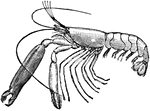
Red Shrimp
"Alpheus-A genus of macrurous decapodous crustaceans, the type of the family Alpheidæ."-Whitney,…

Shrimp
"They are distinguished by the possession of a large oval or triangular appendage which covers the base…

Shrimp
"Shrimp is a popular name for any individual of the genus Crangon, allied to lobster, crayfish, and…
Shrimp
An extensive genus of ten-footed crustaceans. They resemble the lobster and crawfish, but differ from…

Shrimp
An extensive genus of ten-footed crustaceans. They resemble the lobster and crawfish, but differ from…
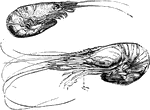
Shrimp
Small, swimming, decapod crustaceans classified in the infraorder Caridea, found widely around the world…
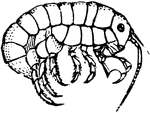
Amphipod
Amphipoda include over 7000 described species of small, shrimp-like crustaceans. Most amphipods are…

Prawn
A small crustacean about 3 to 4 inches in length and marketed in vast numbers. Ate throughout the world.

Brine Shrimp
A species of aquative crustaceans that are found worldwide in saltwater, but not in oceans.

Apus Stages
"Three stages in the development of Apus. fs, frontal sensory organ; L, digestive gland; s, carapace;…
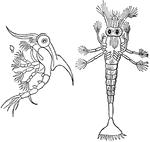
Zoea Taurus
"The lowest division of articulate animals is the Crustacea. Their name signifies a hard crust of covering,…

Common Shrimp
The Common Shrimp (Crangon crangon) is a shrimp fished mainly in the North Sea. The species is also…
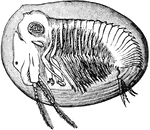
Estheria
Estheria californica is a species of Branchiopod crustaceans most closely resembling the shrimp.

Fairy Shrimp
The Fairy Shrimp (Branchipus diaphanus) is a species of crustacean belonging to the Anostraca order.

Freshwater Shrimp
The Freswater Shrimp (Gammarus pulex) is an amphipod in the Gammaridae family of scuds.

Fairy-shrimp
The class of crustacea is divided into two sub-classes, Entomostraca and Malacostraca. The first, Entomostraca,…
Shrimp
The larger, more useful and more familiar Crustacea belong to the subclass Malacostraca. It comprises…

Prawn
Prawns are crustaceans, belonging to the sub-order Dendrobranchiata. They are similar in appearance…

Marine Isopod
The marine isopod or sand flea (Caprella) is an omnivorous feeder that eats detritus, one-celled plants,…

Metamorphosis of a Crab
Crabs are decapod crustaceans of the infraorder Brachyura, which generally have a very short projecting…

Metamorphosis of a Crab
Crabs are decapod crustaceans of the infraorder Brachyura, which generally have a very short projecting…

Glass-Crab Lobster Larva
"Glass-crab (larva of Palinurus). GLASS-CRAB. A crab of the spurious genus Phyllosoma, or of the spurious…

Mantis Shrimp
Mantis shrimp or stomatopods are marine crustaceans, the members of the order Stomatopoda. They are…










